Archives Hub feature for February 2018
In 2018 a project will commence to restore and enhance Canterbury Cathedral’s organ, due for completion in time for the 2020 Lambeth Conference, when Anglican bishops from all over the world assemble in Canterbury. The first organ was installed at Canterbury in the 12th century although it is believed that unlike its modern counter part, it was not viewed as a musical instrument, rather “a producer of cheerful though fairly random noise.”[1] The current organ was built in 1888 and underwent a number of renovations in the twentieth century. To mark the commencement of the Organ Project, funded through the Canterbury Cathedral Trust, here is an enticing overture of musical collections held by Canterbury Cathedral Archives and Library.
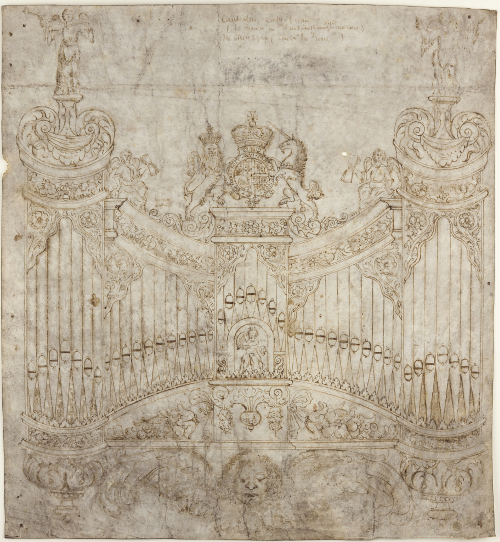
Music in the Aisles
There has been a tradition of music as an integral part of worship at Canterbury Cathedral since its foundation over 1,400 years ago and there is evidence of this in both the fabric of the Cathedral itself and the collections it holds. The Cathedral’s medieval archive was added to the UNESCO UK Memory of the World Register in 2016. This outstanding nationally significant collection includes over 8,000 charters, 30 of which date from before 1066. The collection of medieval music of the Cathedral is principally made up of fragments of music manuscripts from the 11th century onwards. This is partly as a result of the practice of music manuscripts being reused when the music became obsolete during the Middle Ages, and then later due to the Cathedral’s service books being mostly destroyed, dismantled or given away after the Reformation. A number of music fragments were re-used to bind later manuscripts, such as the fragment of 14th or 15th century antiphonal music pictured below, which was re-discovered in 1937 as part of the cover of a Court Book (CCA-DCc/AddMs/128/9).
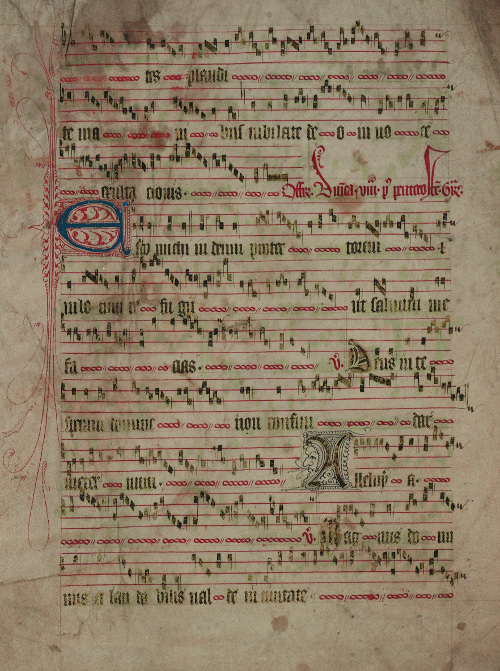
has been drawn in one of the capital letters of an antiphonal fragment (CCA-DCc/AddMs/128/9)
A number of missals are also included in the collections held by the Cathedral Archives and Library. The Plumptre Missal is a particularly fine example of a Sarum Missal containing all the text and music required to celebrate mass and the variations for feast days (CCA-U53/1). Illuminated throughout this mid fourteenth century missal was written at the request of the Stathum family, lords of Morley, Derbyshire, presumably for use in Morley Church. The missal included in the collection of records from St Augustine’s College, a Canterbury based missionary college, is believed to have originally been used by All Saints’ Church, Woodchurch in Kent (CCA-U88/B/6/1). The missal, which is in two columns in red and black ink, with simple illuminated initials in blue and red and a small number of further illuminated borders for certain feast days, is extravagant for a parish church and possibly the gift of a wealthy donor. It shows evidence of having been heavily used since the time it was written circa 1430.
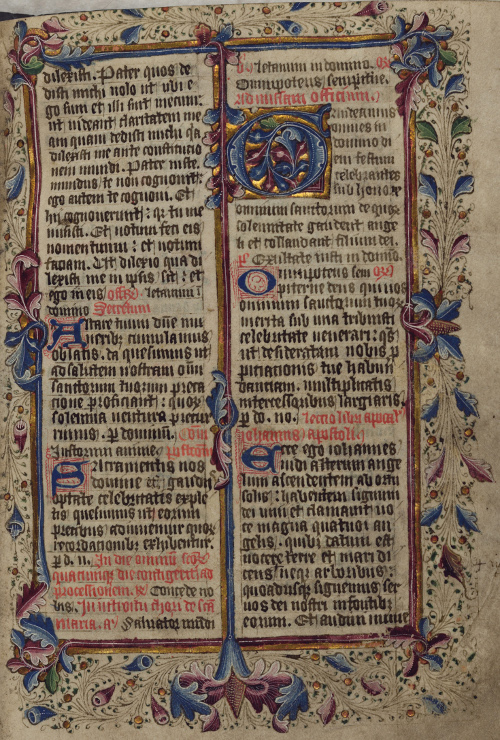
church at Woodchurch is dedicated is elaborately illuminated (CCA-U88/B/6/1, folio 52)
Records relating to the Cathedral Choir are a significant part of the Cathedral’s collection of music. The archive holds the various part books used by the choir from the seventeenth century to the present day (CCA-DCc/MusicMS). These manuscripts include service settings and anthems for contratenor (alto), tenor and bass voices and comprise music for the choir, the organ and, occasionally, other instruments. The records of the Canterbury Cathedral Choir School (CCA-U166) contains accounts, administration files, records relating to pupils and performances and a wonderful series of photographs dating from 1881 onwards. This archive provides an insight into all aspects of the life of a chorister, including worship, musical practice and performance, study and leisure.
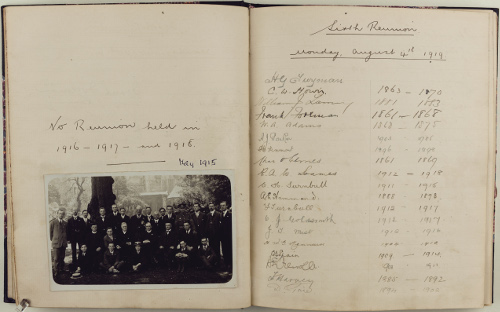
Music in the Streets
In addition to the religious music one would expect in a Cathedral archive the collections also contain a surprising range of secular music and music ephemera as part of the wide range of collections held on loan. Examples include handbills and programmes for musical and theatrical performances in the collection of personal diaries, notes and memorabilia of Alfred E. Johnson, a Canterbury based sugar-boiler (CCA-U520/6), and a collection of music hall patriotic song sheets held as part of Furley Solicitors Records (CCA-U51/44), both from the nineteenth and twentieth centuries.
Most notable are the records of the Canterbury Catch Club, a musical members’ only society formed in 1779 (CCA-CC-W/7). The members met every Wednesday evening between October and March until it disbanded in 1865 to indulge in music making, alcohol, tobacco, and a considerable amount of merriment. While all members were expected to participate in the performance of amusing ‘catches’, the more technically challenging ‘glees’ were left to those more adept which would have included musicians employed by Canterbury Cathedral. Further music was provided by an orchestra funded out of the subscription fees, and occasional visiting musical celebrities. The minute books of the society along with volumes of music performed by the Catch Club form part of the City of Canterbury’s large and varied archive which is housed at the Cathedral.
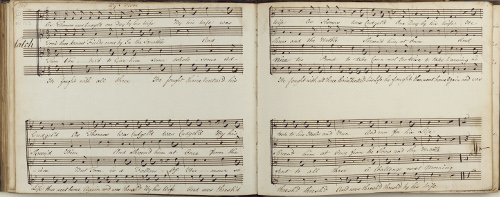
You can find out more about collections on the Canterbury Cathedral webpage: https://www.canterbury-Cathedral.org/heritage/archives-library/.
Ashleigh Hawkins, Archivist
Canterbury Cathedral Archives and Library
[1] “The Liturgy of the Cathedral and tis Music, c.1075-1642” Roger Bowers, A History of Canterbury Cathedral, P. Collinson, N. Ramsay and M. Sparks 2002, p 417
Related
Records of the Dean and Chapter of Canterbury Cathedral, c800 – [ongoing]
All Canterbury Cathedral Archives collections on the Archives Hub.
All images copyright of the Chapter of Canterbury and reproduced with the kind permission of the copyright holders.
